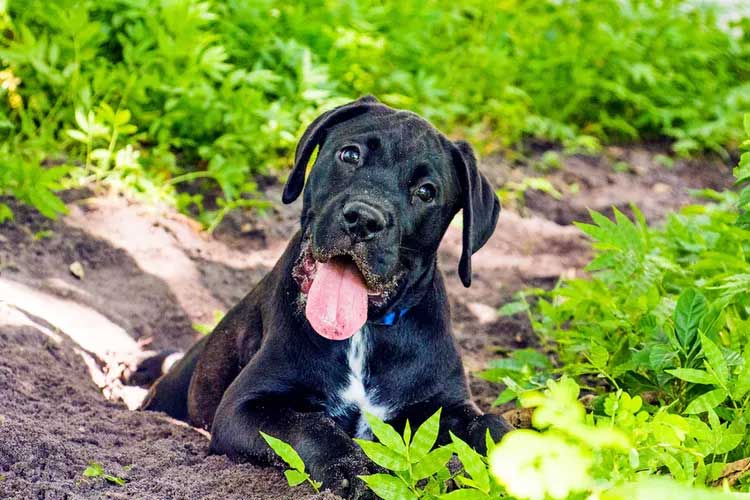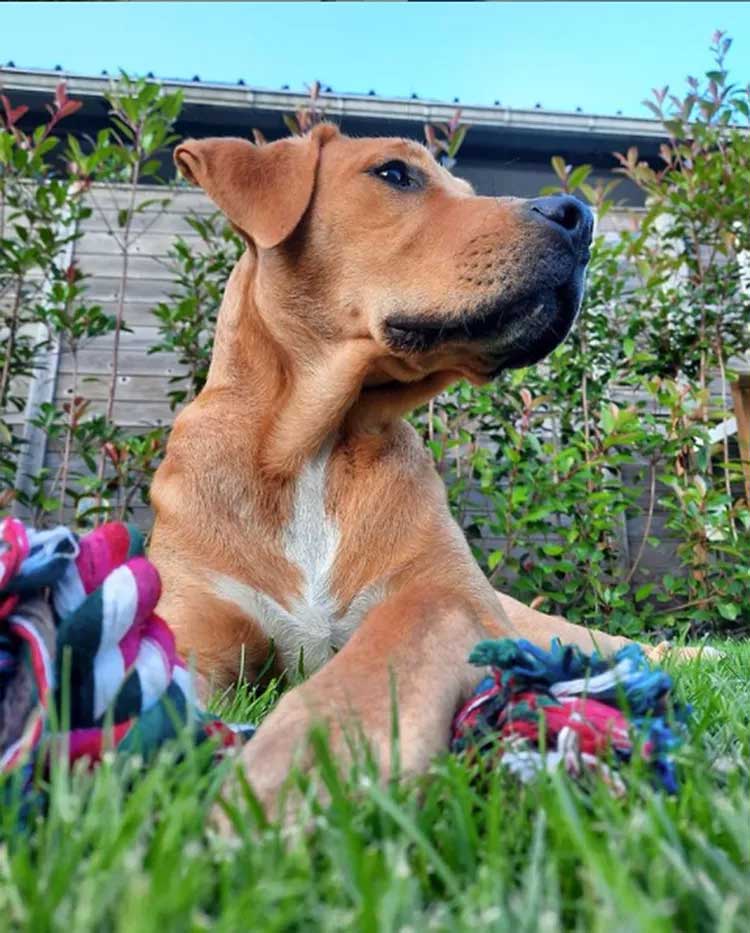Boxadors are high-energy dogs that need to be kept busy and want to remain close to family. Learn more about living with this loyal boxer-Lab mix.

Boxador Overview
| OFFICIAL NAME | Boxador |
| COMMON NAME | Boxador |
| PET HEIGHT | 21 to 25 inches |
| PET WEIGHT | 50 to 80 pounds |
| LIFESPAN | 10 to 12 years |
| GOOD WITH | children, dogs, families |
| TEMPERAMENT | friendly, outgoing, playful, willful |
| INTELLIGENCE | high |
| SHEDDING AMOUNT | normal |
| EXERCISE NEEDS | high |
| ENERGY LEVEL | active |
| VOCAL LEVEL | frequent |
| DROOL AMOUNT | medium |
| BREED GROUP | hybrid |
| BREED SIZE | large (61-100 lbs.) |
| COAT LENGTH | short |
| COLORS | black, brown / chocolate / liver, fawn, gold / yellow, white |
| PATTERNS | bicolor, brindle |
| OTHER TRAITS | easy to train, good hiking companion, strong loyalty tendencies, tendency to chew |
The boxador comes from two of the most popular dog breeds in the U.S.: the boxer and the Labrador retriever. The boxador is an active dog who's affectionate and loyal to her entire family. As a mix of two highly intelligent breeds, she has earned a reputation for being easy to train and eager to join any family adventure. But she also comes from two high-energy breeds and needs to be kept busy.
As a hybrid dog, the boxador can vary in size depending on which parent breed she takes after the most. She will likely stand about 2 feet tall and weigh between 50–80 pounds. At her best, every inch of the boxador is filled with exuberance and love. She will need an active owner who can match her endless stamina, and she will be happiest when kept close to her people.
Appearance
The boxador is perpetually ready to play. Her toned, muscular body is frequently in motion, often chasing a ball or trying to start a friendly game of tug-of-war.
Depending on how much she takes after her boxer lineage, she will likely have a relatively squared head and loose jowls. Even if she has the longer snout of the Labrador retriever, she will likely still have droopy jowls. Because of this, she might be prone to drooling—especially when she gets excited.
Both of her parent breeds are large dogs, so your boxador will grow up into a big bundle of energy. The boxador is expressive with her eyes and ears, often looking at you with a longing glance and perked up ears to tell you she's ready to go for a long walk.
If she takes after her boxer side, her coat will be short and won't shed much. However, because a Labrador's coat can range from short to medium in length, a boxador will likely experience seasonal shedding. The boxador can come in a mix of colors, with the dominant shades being fawn, brown, black, or brindle. And while it's not guaranteed, the boxador often has a white patch on her chest and a muzzle of black fur.
Temperament
The boxador's personality is a blend of the outgoing Labrador and the playful boxer. This means the mixed breed is ideal for many on-the-go families, as long as you make sure you have time to play with your boxador every day.
Amy Potts, director of Great Lakes Boxer Rescue in Sanford, Mich., compares these high-energy boxer hybrids to toddlers because they need constant engagement.
"They're mixes of boxers and Labs, so they're high-energy," Potts says. "They are cute, and people forget that they need to be kept busy or they will get bored. Bored dogs are not good dogs because they're going to chew on belongings. They need families that are going to be active and keep them busy."
Attention and affection is what the boxador most desires. She gets along incredibly well with children and other dogs, especially if she is well-socialized as a puppy. Boxadors are motivated by praise and affection, so owners should train her using positive reinforcement training and give her plenty of attention when she does something correctly. She will be highly motivated to learn different games alongside you.
Both parent dogs are known for their intelligence and ability to communicate exactly what they need with their owners. So pay attention when your boxador is whining or nudging you—that probably means she needs to go outside (or just wants some more playtime).

"They will make great dogs because the boxer and Labrador are both dogs with a good temperament," Potts says. "But people need to do their research. You need to get them all kinds of games and activities. Take them on a jog or play fetch, all of that good stuff."
Living Needs
To give your boxador the best possible life, she needs two things: exercise and human interaction. She's not going to want to entertain herself in a fenced-in yard; she wants you to play with her.While she is a well-tempered dog, the boxador should not be left at home for hours alone. If left by herself, the boxador can be prone to make her own entertainment (think: chewing decorative pillows or pulling over houseplants) to keep herself entertained.
Loretta Moraco, a director at Chelsea's Hope Boxer Rescue that works with boxers and boxer mixes in the Northeast, says many people don't understand the energy level these dogs bring to a household.
"This is a dog who needs to be socialized [and] who wants to be socialized," Morocco says. "You cannot just put the dog in the yard alone."

It's also important to give your dog a safe space where they can go when she's tuckered out, such as a spacious crate. By training your boxador that her crate is a safe, comfortable space, she will feel more secure there whenever her owners do need to leave her alone for a short period of time. Crate training can also limit undesirable behavior that can happen when boxadors get bored.
"They need to be crate trained as puppies because they are big chewers," Moraco says. "It's a safety move. The boxer side is mischievous and curious, and you don't want them eating something they shouldn't when left alone."
Care
When bringing home a boxador puppy, it's important to commit to taking her to obedience classes (like puppy kindergarten) and positively reinforce her good behavior.As a general rule, boxador owners should be prepared for a dog that wants to run and play 99 percent of the time. While there are some exceptions, boxador owners need to be ready to take their new pet on long, daily walks. She is exceptionally friendly thanks to her Labrador side, and she will thrive when socializing with other humans and dogs.
"They need to run and play," Potts says. "They want to go with you. They need doggy daycare and activities and games outside. They're literally like a toddler for a really long time, that's the best I can describe it. Keep them busy, and don't let them get bored."
A weekly brushing will keep your boxador's coat looking its best. It's a good idea to get her used to regular teeth brushing as a puppy because her boxer side can be prone to dental issues. If she has face folds (particularly around her mouth), you'll want to keep them clean with regular bathing in order to avoid any bacteria buildup.
Health
A healthy boxador can live between 10–12 years, but they are likely to experience health issues in their lifetime. Owners should consider investing in pet insurance if they bring home a boxador because both breeds are prone to certain health conditions that can become expensive in their older years.A boxador's health largely depends on what genetics she inherits from her parents and grandparents. The Labrador side often experiences elbow and hip dysplasia, according to the Labrador Retriever Club. These issues can be addressed with joint supplements recommended by your veterinarian. They can also experience certain heart disorders, as well as a condition called exercise-induced collapse.
The boxer parent's genes can make boxadors predisposed to cancers that often impact the brain, thyroid, or spleen, according to the American Boxer Club. They can also be at risk for hereditary heart diseases, including arrhythmogenic right ventricular cardiomyopathy or Aortic Stenosis. They could experience discomfort with her hindquarters later in life if they inherit the boxer's predisposition to degenerative myelopathy.
The popularity of boxer hybrids (including the boxer-Lab mix) in recent years has actually been, in part, an effort to mitigate some of the more heartbreaking health conditions that impact the purebred dogs.
"Most boxer mixes act exactly like pure boxers," Moracosays. "They have a lot of energy. They are great with kids, smart, and goofy. And a lot of people who love the boxer breed are now looking for a hybrid dog because they are hoping it eliminates some of the health issues."
Owners should be ready to work with their veterinarian to screen for possible health issues. While many boxadors live long and healthy lives, being aware of the potential health issues is the best way to ensure she is kept comfortable and happy.
History
As a hybrid dog, the boxador's origin is murky. Mixed breeds are not registered by the American Kennel Club, so their history is undocumented (unlike purebred dogs whose history goes back for centuries).The most likely explanation for the boxador is that breeders sought to combine the best traits of the two beloved, active breeds. Especially for owners who worry about the health issues surrounding the boxer breed, the Labrador retriever—as the nation's most popular dog—makes an optimal pairing to offset some of the boxer's health risks.
While the boxador's history is largely speculation, she comes from very famous parents. The Labrador retriever originated in Canada as a loyal waterfowl dog before gaining a reputation as a loving family dog. The boxer is the product of breeders in Germany and Belgium who wanted a strong hunting dog. Eventually, the boxer became a farming dog who enjoyed spending time with her family.
Because the boxador can be prone to certain health issues, it's especially important that potential owners get health records for the dog they are adopting). If you are bringing home a puppy from a boxador breeder, take steps to avoid a puppy mill scam by working with individuals who are transparent about health screenings and allow you to meet the puppy on-site so you can ensure she was raised in a good home.
Fun Facts
In 2021, the Labrador retriever was named the most popular dog breed for the 30th year in a row. The same year, the boxer was named the 14th most popular dog breed in the United States.
A rescued boxador named Wesson is the frequent star on the popular TikTok account @willandwesson.
Wesson isn't the only social boxador—you can also follow @fennatheboxador and @jackson_boxador on Instagram.